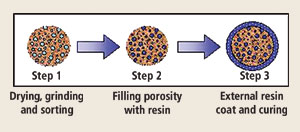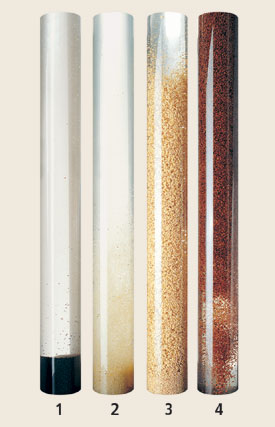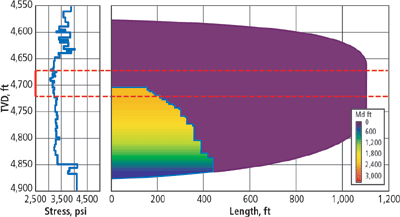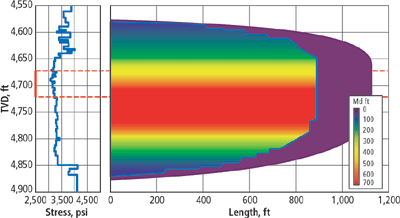Drilling and Completion Technology
Low-density propping agents improve hydraulic fracturing in the Permian basin
A new proppant created from ground particles filled/ coated with resin remains nearly buoyant in water-based
frac fluids to more efficiently pack created fractures for greater, sustained fluid inflow.
Randall Edgeman, BJ Services Co., Midland, Texas
This article summarizes the development of low-density propping agents for primary applications in water fracs. The use of these new proppants
in improving transport and more complete packing of created fractures is discussed. And illustrations show comparative fracture cross-sections, packed with conventional
proppants, that only create a proppant bank around the wellbore, with one packed to a high-percentage of the fracture's total length and height using lighter-weight
proppants. To date, more than 130 frac treatments have been performed in the West Texas Permian basin using this patented new technology, basically using a manufactured,
low-density material called LiteProp.
INTRODUCTION
Hydraulic fracturing has experienced an amazing array of innovations and technical advancements since its inception in the late 1940s. The oil
and gas industry continues to rely on fracturing to develop resources in mature basins and other areas with marginal production economics. The Permian basin in West Texas
exemplifies both criteria and, therefore, has had a long, successful history with respect to fracture stimulation.
In its purest form, hydraulic fracturing offers a means to part a formation with fluid pressure and create highly conductive flow paths
extending laterally from the wellbore to increase production. Typically, a propping agent, or proppant, is placed in the fracture to ensure that the flow path remains open
after hydraulic treating pressure is released.
Technical advancements over the past two decades primarily focused on development of increasingly cleaner and more efficient fracturing
fluids, typically cross-linked (gelled) polymer systems. Proppant technology, on the other hand, has not benefited from the same degree of research and innovation (with the
possible exceptions of resin-coating and ceramic particle technologies). This is because the physical dimensions of any particular fracture constrain the finite amount of
proppant that can be physically placed.
This puts an upper limit on the conductivity of the final proppant pack. Historically, the industry has sought “ideal” fracturing
fluids that maximize proppant transport, yet minimize the damage imparted to the formation and final proppant pack conductivity. These two design criteria are by nature
diametrically opposed; hence, the ongoing R&D challenge.
PROS AND CONS OF WATER FRACS
We have long recognized that un-gelled water is one of the cleanest and most economic fluids for fracturing. Where formation compatibility
issues and fluid leak-off are minimal, there has been substantial interest in using un-viscosified water as a primary frac fluid. These treatments are commonly referred to as
water fracs, slick-water fracs, or (occasionally) dendritic fracs. This type of frac job typically involves pumping very large amounts of water, with friction reducer and
relatively small volumes of proppant, at very high rates. Where applicable, such treatments produce adequate results at a reduced total cost, compared to those using
traditional gelled fluids – making water fracs more economically viable than fracing with gelled fluid systems.
Like all stimulation techniques, water fracs have their advantages and disadvantages. The key with this particular technique is candidate
selection, i.e., applying it to areas or formations suited to its unique advantages. Potential water frac advantages include:
- It is operationally and chemically straightforward.
- Very long hydraulic frac lengths can be generated.
- IP rates can be comparable to conventional treatments.
- Costs are less than conventional treatments.
As might be expected, water fracs also have several disadvantages, for example:
- Limited to low sand concentrations
- Rapid screen-out potential
- Short effective frac lengths
- Resulting production declines are steeper than similarly sized conventional jobs
- Water zones below are particularly risky.
Virtually all of the disadvantages associated with water fracturing are symptoms of poor proppant transport. So if proppant could be placed
effectively by water, the potential negative consequences would be greatly diminished, or eliminated entirely.
In its simplest terms, a fluid's ability to carry or transport a particle is proportional to the settling velocity of the particle relative to
the surrounding fluid. Since the fluid in question is water (Newtonian), the terminal settling velocity (Vt) of any particle (proppant) can be estimated using Stokes' law:
Vt = (rp – rf
) gcdp2 /18mf
| Where: rp |
= |
Proppant density |
| rf |
= |
Frac fluid density |
| gc |
= |
Earth's gravitational constant |
| dp |
= |
Mesh size, and |
| mf |
= |
Fluid viscosity. |
Since water fracing has been proven to be a popular and cost-effective method to stimulate many marginal reservoirs, given that its major
drawback is poor proppant transport, it was logical to ask: “Is there a way to improve the proppant transport characteristics of water?” For an answer, Stokes' law
was examined on a variable-by-variable basis to find a way to decrease the terminal settling velocity of proppant in the carrier fluid (in this case, water).
IMPROVING WATER-FRAC PROPPANT TRANSPORT
The most common method to reduce settling velocities is decreasing the diameter (dp ) of the proppant. This approach is
particularly effective since the diameter term is squared in Stokes' law; thus, if the diameter is cut in half, the settling velocity is cut by a factor of four. However,
this technique has its limits, since proppant conductivity is also proportional to diameter, with an exponent that is (unfortunately) greater than two. This means the
settling benefit gained by reducing diameter is rapidly offset by the resulting reduction in fracture conductivity.
Similarly, other variables in Stokes' law were examined. It stands to reason that viscosity (mf)
of the fluid could be increased to reduce the proppant's terminal velocity. But gelling the fluid negates the benefits of water fracing. Altering the frac fluid density (rf)
was deemed impractical because, to achieve parity with proppant (sand) density, one would need to find an economic source of 22.1-ppg non-damaging fluid – not very
likely!
This process of elimination determined that the most practical way to improve proppant transport in water would be to decrease proppant
density until it approached carrier fluid density. Obviously, since the fluid in question is water, that requires a prospective proppant to have a specific gravity as close
as possible to one. The prospective material would also need to provide adequate conductivity across as wide a range of closure stress and temperature as possible.
FINDING EFFECTIVE, LOW-DENSITY PROPPANTS
Many different compounds were investigated in the search for a material that exhibited low specific gravity and a useful conductivity range.
Extensive lab screening against the previously mentioned design constraints led to selection of a cellulosic substrate, impregnated with and encapsulated in, a pre-cured
resin coating. The organic nature of the substrate provided substantial porosity that could be filled with low-density resin to achieve both strength and a low specific
gravity. The entire particle was coated with an external film and cured both to protect the substrate from degradation and to add additional closure resistance, Fig. 1.
 |
|
Fig. 1. Low-density proppant preparation. |
|
The result of this process is a proppant with roughly the same conductivity characteristics of Ottawa (Jordan) sand, yet has an average
specific gravity of 1.25 g/cc. Sand has a specific gravity of 2.65 g/cc, and premium man-made proppants can have specific gravity as high as 3.55 g/cc. This density
difference means the new low-density proppant particle will settle at a rate up to 6.6 times slower than a similarly sized sand particle in fresh water. This decrease in
terminal settling velocity will translate into significantly longer proppant transport distances. Additionally, when the low-density particles are placed in a saturated
10-ppg brine (sg = 1.2), the resulting settling rate is so low that the particles are almost neutrally buoyant.
The photo in Fig. 2 illustrates the dramatic difference in settling rates exhibited by two conventional fracturing proppants, vs. two
ultra-lightweight proppants in an otherwise static 9.5-ppg brine solution. The 20/40-mesh proppant materials, left to right, are: bauxite, Ottawa sand, LiteProp 175 and
LiteProp 125. The brine-filled tubes were inverted just two seconds before this photograph was taken, in a controlled environment.
 |
|
Fig. 2. Different settling rates in 9.5-ppg brine solution of two conventional proppants, bauxite (1), Ottawa sand (2), and two
patented ultra light-weight proppants, LiteProp 175 (3) and LiteProp 125 (4). |
|
MODELING LOW-DENSITY PROPPANT PERFORMANCE
In terms of propped length, the decreased settling rate exhibited by the low-density proppant yields significantly longer fractures than
previously possible with conventional sand in a water frac. Fig. 3 represents a typical post-frac proppant distribution, in which the sand created a proppant bank or dune
adjacent to the wellbore. Conductivity of this sand pack is usually very high due to high areal concentrations associated with this type of proppant distribution.
 |
|
Fig. 3. Conventional water-frac, post-frac proppant distribution profile. |
|
However, the figure also illustrates that the entire pay interval was not propped and the effective propped length is not optimal, given the
created hydraulic fracture length. This type of fracture treatment on a low-permeability zone would result in a production stream that declined rather quickly and did not
drain the entire net payzone thickness.
To improve the performance of the completion represented in Fig. 3, it was decided to take advantage of the almost non-existent settling rate
of the low-density proppant in a 10-ppg brine carrier fluid. Fig. 4 represents the resulting fracture profile of the same example used in the conventional water frac
scenario. However, with this simulated treatment – in which pumped fluid volumes are identical to the previous example – the mass of low-density proppant placed was
just 1/5 that of the sand example. Additionally, this smaller proppant mass was pumped in filtered 10-ppg brine.
 |
|
Fig. 4. Fracture profile with low-density proppant in 10-ppg brine carrier fluid. |
|
The low-density particles are carried without the excessive settling associated with typical water fracs. This scenario also results in a
completion in which the entire pay thickness is propped open, creating an effective propped length about four times greater than the sand example. The resulting conductivity
is lower than with sand, but given the low permeability of the candidate wells, the created fracture length dominates completion results.
PROVING EFFECTIVE IN RE-FRACS AND WATERFLOODS
This type of treatment is proving particularly effective in re-stimulating older wells with low permeability, and in stimulating marginal pay
that had been bypassed due to poor economics. Typically, the post-frac fluid entry rates from these low-density propped fracs can be as high as seven fold over pre-frac
conditions. These results have even been observed in wells previously fractured with conventional proppants.
The new low-density proppants have also been used to treat under-performing wells in mature waterfloods that have been previously stimulated.
Frequently, these particular wells flowed for a significant amount of time after the frac, even though they were in a “pumped-off” condition prior to
re-stimulation. Measured pressures suggest that either: 1) the frac exceeded the original drainage radius, or 2) it contacted pressure support from an offset injector.
Although it has not yet been determined, which is the case, both scenarios would require significantly longer effective frac length than had been previously achieved.
PURSUING DATA TO EVALUATE FULL POTENTIAL
To date, more than 130 fracture treatments have been performed in the Permian basin using this patented, new low-density, ultra-lightweight
proppant. The innovative nature of this low-density proppant material means the well design optimization process is ongoing. Many different techniques to place the material
have been proposed and tried in the field.
These techniques are primarily focused on taking advantage of the low settling rates these proppants exhibit. However, other benefits include
the ability to maximize effective fracture length by increasing the propped area within the fracture. Additionally, the low-viscosity carrier fluids that can be used with
low-density proppants will create greater fracture length, vs. height, and improve areal coverage.
Proppant monolayers. Ongoing efforts with several Permian basin operators will create a critical mass of treatment data that will
yield better evidence of these products' full potential. A major area of interest is the investigation into creating partial proppant monolayers. This phenomenon was well
documented in the fracturing research literature in the 1960s.
The concept behind creating a partial monolayer is to place proppant into a fracture width equal to one particle diameter. Researchers
historically tried to determine the optimal proppant concentration, just below what a full monolayer would require, to maximize resulting conductivity while using a minimum
amount of proppant. This concept derived from lab conditions proved difficult, if not impossible, to replicate in the field due to the technological limitations of the day.
Analysis of recent post-frac results combined with an examination of estimated areal proppant concentration suggests that a proppant monolayer
is probably being created with low-density proppants.
Reasons for monolayer success. It is believed that, this time, creation of partial monolayers might be successful for these reasons:
1) Gelled fluids are used to transport proppant laterally. With low-density proppants, fluid viscosity is not needed; 2) When non-viscosified fluids are used (in water or
slick-water fracs), conventional proppants settle quickly and final distribution varies too much to create a monolayer. This does not apply to the new low-density proppants;
and 3) Proppant embedment in the fracture face becomes significant at very low proppant concentrations. The highest success rates achieved with these new low-density
proppants have been in very high modulus dolomites.
SUMMARY
Low-density proppants have opened new opportunities for hydraulically fracturing wells in the Permian basin. The low specific gravity of these
materials allows fracturing treatments with non-damaging fluids to place propping agents at greater distances from the wellbore than has been possible with gelled systems.
This greater propped (or effective) frac length manifests itself in well performance superior to conventionally treated offset wells. 
THE AUTHOR |
 |
Randall Edgeman, region engineer for BJ Services Co., Midland, Texas, graduated from the University of Oklahoma in 1987 with a BS in
petroleum engineering. He has 17 years of combined industry experience with various service companies and operators. |
| |
|
|







